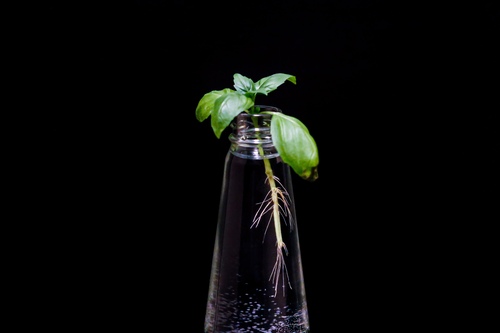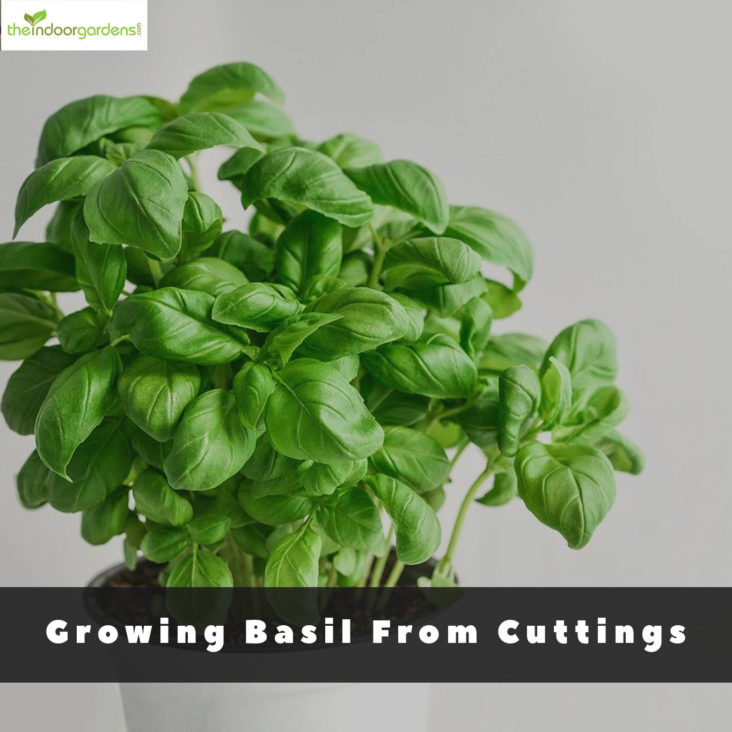Basil is a deliciously fragrant herb, and one of my favorites to grow both for it’s cooking uses as well as its beauty. I often find myself growing basil just to get that wonderful aroma it gives off. We’ve talked about growing basil before, but one thing we didn’t look at in-depth is growing basil from cuttings. This is a simple technique that allows you to use your existing basil plant to grow new ones. If you’re an avid herb gardener, then this is a quick tip to get more out of your garden that costs you almost nothing. There are two main methods to growing basil from cuttings, we’ll look at each below in detail.

Tip
A cutting is a small piece of an existing plant you can use to re-grow a new one. There are many plants which can be propogated through taking cuttings.
Growing Basil From Cuttings - Water Method
The water method process is very simple and can be broken down into 3 key steps. Once you’re done, you’ll have a full basil plant ready to harvest. This method involves growing the basil cutting in water for a few weeks before moving it to a container. I find that I have more success with this method, but it does involve an extra step so is a bit more involved than the one discussed below.
Take a Cutting
Start by taking a cutting of basil from an existing plant that is roughly 3-4 inches in length. I usually start with 3-4 of these cuttings as it’s not uncommon for one to not make it. Even if you do everything right it’s sometimes just too much of a shock to the plant, so make sure to plan, and plant, accordingly.
You also want to make sure you start with a healthy parent plant. Taking a cutting from a sickly plant not only makes the chance of failure higher, but also risks further damaging the parent plant.
Put it in Water
Next, place the cutting(s) into a small container of water and wait. I usually use a mason jar for this, but any similar size container will work. Place the container in an area that gets a decent amount of sun like a nice kitchen windowsill. You also want to change out the water every other day to keep it fresh. Sitting in old water is not good for the plant.
Another important thing to watch is the plant’s temperature, you don’t want it to drop too low. This is usually only a concern near drafty windows, but watch out for this, especially at night when there is no light for warmth.
You can also opt to use rooting hormone at this step in the process. These products help your cutting produce roots, which can speed up this step. That said, you can be sucessful without them, so they’re not strictly necessary.
While it sits in this container it will eventually begin to sprout roots.

Move to a Pot
After all that it’s a simple waiting game. You want to wait until roots are about 2 inches long before you move it to its permanent home. Once the roots do reach that length, you can simply pot your cutting like you would any other plant. This whole process can take anywhere from 2-4 weeks from cutting to potting. From then on, simply care for it as you would any other basil plant.
If you don’t see roots with 3-4 weeks, then it may be time to start over with a new cutting.
Growing Basil From Cuttings - The Soil Method
For a more direct planting approach, place your basil cutting directly into potting soil. I find this one to be a little more hit-or-miss, but is a bit simpler than the above water method.
Prepare Your Containers
To use potting soil to plant cuttings, you’ll need a few supplies. First, you’ll need a pot with a diameter of 4 inches and drainage holes. You’ll also need potting mix, plastic plant domes or clear plastic bags, and a few basil cuttings. Feel free to use a lot here to increase your chances, you can always cut back your seedlings if the container is overcrowded.
Fill your pot with potting soil and add a small amount of water to dampen it. You can place multiple cuttings in the same container.
Take The Basil Cutting
Though you can prepare your basil cuttings beforehand, it’s best to wait until after the pots are ready to trim their ends and remove the lower leaves. Doing so prevents the ends from drying out. Do so the same as you would with the water method by taking multiple cuttings about 3-4” in length.
Plant the cutting
Make a small hole in the the potting soil and insert the end of the cutting. Press the soil around the end to hold it upright and in place. Repeat this process for each of the cuttings you’ve prepared.
Once planted, place your cuttings in an area with bright, indirect sunlight. Then carefully cover the basil cutting with a plastic dome or clear bag. Doing so locks in the humidity to create a makeshift greenhouse.
Monitor the cuttings
Each day, remove the dome or bag from the cutting and mist the soil with water. Do not let the soil dry out completely or your cutting may not survive. After about two weeks, you can gently tug the cutting. If it doesn’t come free easily, it has sprouted roots. At this point you can remove the plastic and continue with normal care. If not, replace the bag and try again in a week.
If you’ve got multiple cuttings that have survived in a single container then now is a good time to prune them back. You want to give each plant at least 4” of space.
Caring For Your Basil
After you move your basil to its permanent home, or it has sprouted roots, you can pick up on normal care. Here’s a quick overview on how to properly grow basil.
- Basil likes medium light, about 6-8 hours per day. Opt for indirect light as direct light can harm the plant.
- Water when the soil is dry to the touch. Overwatering is a big problem, so opt to be too careful here over watering too much.
- Basil grows well in a variety of containers, everything from small windowsill pots to entire garden beds will work.
- Harvesting is easy, simply pick off the leaves as you need them. Try not to ever pick more than about 1/3 of the plant at one time so it has the strength to regrow.
This is just a quick overview, and proper care is slightly more involved. We have you covered there; check out our guide to growing Basil. It specifically targets indoor gardeners, but the care will be similar if you plan to grow it outdoors. Follow all these tips and you’ll be enjoying delicious basil all year long.
Growing Basil From Cuttings
That’s all there is to it. The process is very simple, and is a great way to recycle your plant. Cuttings also make a great gift for friends and family that are gardeners. The other great thing when indoor gardening is you can grow basil from cuttings all year round. Learning how to take and grow cuttings is a great skill for any gardener to master.
Frequently Asked Questions
Are Basil Cuttings Rooted In Soil or Water?
Basil cuttings can be successfully rooted in soil or water.
How Long Do Basil Cuttings Take To Sprout Roots.
Generally about 2-3 weeks. If your plant hasn't sprouted roots in over 4 weeks then it may be time to start over.
What Size Should Basil Cuttings Be?
Take cuttings of about 3-4 inches in length.







